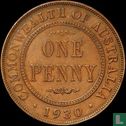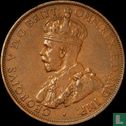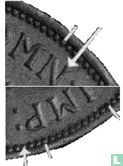


Enlarge image



Catalogue information
LastDodo number
4677383
Area
Coins
Title
Australia 1 penny 1930 (english reverse)
Country
Year
1930
Variety / overstrike
Head of State
Type
Designer
Series
Theme
Material
Weight
9.4
Diameter
30.8
Thickness
Punch
Shape
Obverse
COMMONWEALTH OF AUSTRALIA ONE PENNY · 1929 ·
Reverse
GEORGIVS V D.G.BRITT: OMN:REX F.D.IND:IMP:
Edge
Plain
Privy mark
Mint mark
Number produced
3.000
Krause and Mishler number
KM# 23
Catalogue number
Details
With the Great Depression taking hold, the Melbourne Mint had no orders to strike 1930 pennies for circulation. However, in July of that year three 1930 penny reverse dies were derived from a 1929 master for the intended purpose of striking specimens. On August 13, 1930 twelve specimens were produced using one of these reverse dies, which was allied with an Indian obverse die taken from a master that had been sent directly from London in 1922. No further pennies were struck by the Melbourne Mint in 1930. It was not until August of the following year that the three 1930 reverses along with both English and Indian obverse dies were utilised for experimental purposes. Production from these dies is recorded as nil thousands, i.e. less than 1,000 coins per die which even then appears grossly overstated regarding the English obverse type of which only three surviving examples have surfaced. Evidence suggests that only one bag of blanks was used which, at best estimate, could produce 2,400 coins. However, if it is assumed that the two dies allied with Indian obverses produced under 1,000 coins each and an insignificant number of coins were struck using the English obverse, then the mintage of the 1930 penny must be well under 2,000. The common consensus is that around 1,500 coins were struck in total although this cannot be proved or disproved and this figure may still be an overestimation. As there were no counters on the coin presses, the annual coin production figures were at best rudimentary being deduced by a count of the number of bags of blanks used. For the stocktake, it was also the common practice for small runs of coins struck for experimental purposes to be returned to an open bag of blanks so that they would be included in the count. It is therefore probable that through the disbursement of the bag containing the experimental 1930 pennies, Australia's best known rarity, made its way into circulation, first coming to the notice of collectors in the 1940s. There are enough penny blanks found in circulation to confirm the theory that bags containing a mixture of blanks and struck coins were on occasion inadvertently released.





